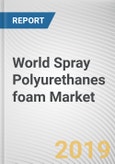The growth of the SPF market is influenced by many factors such as swapping green building techniques, an ageing health conscious population, government regulations, increased demand for bio based products, and greater awareness among end users about the energy usage in the buildings. The limiting factors of the SPF market are the threats it posses to human health. The remnants remain in the natural environment for a period of time from the time it is applied to the walls, and the exposure to the remnants of SPF chemicals found in vapors, aerosols, dust or on the surfaces affect health and cause chronic disease such as asthma. This factor is hampering the growth of the market.
The global market for foamed plastic (polyurathanes) is expected to reach $ 20.40 billion by 2020. High demand for low cost, long lasting materials and rising concern of energy efficiency in applications mentioned above are expected to create lot of opportunities for this market.
SPF type market analysis
The SPF type market is segmented into two-component open cell foam (low density), two-component closed cell foam (medium density), & two-component closed cell foam (high density) and one component foam (OFC). Closed-cell foam is the largest revenue generating segment due to its core strength such as better R-value than open-cell foams.
SPF construction market analysis
The SPF construction market is segmented into commercial construction (light, heavy, and industrial) and residential construction (single family, multifamily). Commercial construction is the largest revenue generating segment due to significant contribution to energy loss.
SPF application market analysis
SPF application market is segmented into residential walls, residential roofing, commercial walls, commercial roofing, and others (medical, telecom, transportation, etc). Commercial roofing is the largest revenue generating segment due to its strength of adding value to the structure. SPF, once applied to the roofs would help in energy consumption, up to 30%-70% and it also acts as a protective shield that enhances the life span of the walls.
SPF geography market analysis
SPF geography market is segmented into North America, Europe, Asia Pacific and RoW. North America is the dominating segment of this market due to its increasing adoption of eco-friendly methods. .
Competitive Landscape
The key strategies adopted by the companies to expand in the SPF market are product launch, mergers & acquisitions and agreements & collaborations. The companies profiled in this report are BASF, Bayer, lapolla, The Dow Chemical Company, Demilec and Certain Teed.
High Level Analysis
The report analyzes various macro environment of the SPF market using porter’s analysis. According to porter’s analysis, the bargaining power of the supplier is high due to high cost of switching. The bargaining power of buyer is low due to the s
Methodology
The analyst offers exhaustive research and analysis based on a wide variety of factual inputs, which largely include interviews with industry participants, reliable statistics, and regional intelligence. The in-house industry experts play an instrumental role in designing analytic tools and models, tailored to the requirements of a particular industry segment. The primary research efforts include reaching out participants through mail, tele-conversations, referrals, professional networks, and face-to-face interactions.
They are also in professional corporate relations with various companies that allow them greater flexibility for reaching out to industry participants and commentators for interviews and discussions.
They also refer to a broad array of industry sources for their secondary research, which typically include; however, not limited to:
- Company SEC filings, annual reports, company websites, broker & financial reports, and investor presentations for competitive scenario and shape of the industry
- Scientific and technical writings for product information and related preemptions
- Regional government and statistical databases for macro analysis
- Authentic news articles and other related releases for market evaluation
- Internal and external proprietary databases, key market indicators, and relevant press releases for market estimates and forecast
Furthermore, the accuracy of the data will be analyzed and validated by conducting additional primaries with various industry experts and KOLs. They also provide robust post-sales support to clients.

LOADING...








